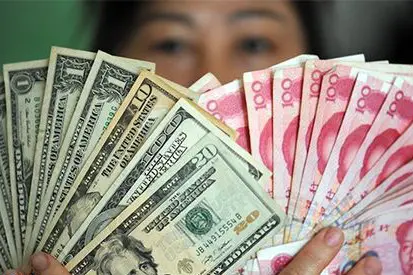The Chinese yuan rose sharply against the US dollar on Thursday, taking advantage of the uncertainty of US fiscal policies and displaying the capability of Chinese monitory regulators to stabilize the currency.
The onshore yuan finished 668 points higher at 6.8817 against the dollar on Thursday, recording the largest daily growth in nearly 11 months.
The offshore yuan against the dollar increased 0.99 percent to around 6.8151 as of 11 pm on the same day.
The US Federal Reserve Board (Fed) officials' worries that US President-elect Donald Trump's economic stimulus plan may impact sustainable development of the US economy weakened the dollar, relieving external depreciation pressure on the yuan, said Liu Jian, a senior research fellow at Bank of Communications.
Fed officials are worried that Trump's stimulus plan will bring "great uncertainty" to the US economy, wallstreetcn.com reported on Thursday, citing minutes of the Federal Open Market Committee (FMOC). The members of the FOMC argued that the upcoming fiscal policy is uncertain because expansive fiscal policy may lead to a currency policy tighter than expected, the report said.
Chinese financial regulators acted proactively to regulate the yuan. The People's Bank of China (PBC) set the central parity rate of the onshore yuan against the dollar at 6.9307 yuan on Thursday, 219 points higher than the previous day.
On December 30 the central bank released tighter regulations on cash transactions and overseas transfers, requiring financial institutions to report cross-border transfers over 200,000 yuan ($29,080).
Besides, a change in the China Foreign Exchange Trade System (CFETS) currency basket and increased supervision also contributed to the rise, E Zhihuan, chief economist of the Bank of China in Hong Kong, told the Global Times Thursday.
Starting from Sunday, the CFETS increased the number of currencies in the basket from 13 to 24, aiming to make the currency basket more representative, said a statement on its website in December. The share of the US dollar is reduced to 0.2240 percent from 0.2640.
The State Administration of Foreign Exchange (SAFE) improved individual foreign exchange application management by requiring banks to check the transactions and whether they violate related rules, strengthening punishment measures, said a statement on the bureau's website on Saturday.
Two-way fluctuation
Experts said that downward pressure on the yuan may continue in 2017, but the currency is unlikely to plunge too sharply as much of the downward pressure has been released in 2016.
"I predict the yuan's exchange rate may see two-way fluctuations next year, changing in line with the US dollar index. But the fluctuation range will contract," E said.
Meanwhile, the committee forecast three rate increases in 2017 due to factors including downward unemployment rate, upward revision of inflation and a change in fiscal policy, according to a statement on the institution's website in December.
Last month, the Fed announced a 0.25 percentage point hike in the federal funds rates to a target range of 0.5 percent to 0.75 percent, effective from December 15, 2016, which will attract currency flow to the US and exert pressure on the yuan depreciation.
However, "the dollar may become weak if the US fiscal and trade deficits deteriorate after Trump implements tax-cutting and expansive fiscal policies. And this means the Chinese currency will not depreciate too much next year," Liu Dongliang, a senior analyst at China Merchants Bank, said in a note sent to the Global Times previously.
In addition, the Central Economic Work Conference, which ended on December 16, stressed to "maintain the basic stability of the yuan at a reasonable level while improving the resilience of the exchange rate."
Liu Jian forecast the authorities may further strengthen foreign exchange transaction supervision to curb capital outflows, as capital flow has been considered a key risk for the Chinese economy in 2017.
Liu from China Merchants Bank said the yuan may reach a bottom line of 7.10-7.15 against the dollar in 2017.
If a depreciation expectation can be controlled, there would be more room for the implementation of monetary policy, E said, noting it will aid the domestic real economy and help ease capital outflow pressure.
(CHINA DAILY)
 简体中文
简体中文

